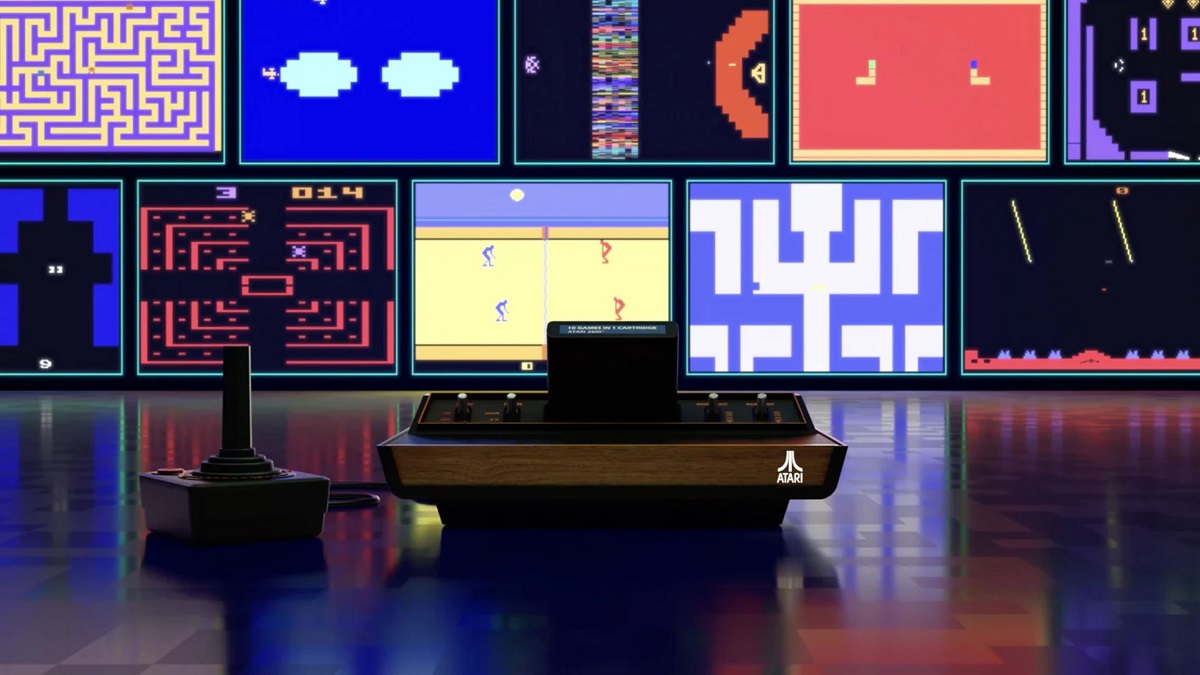Being born late into the ?80s, the Atari 2600 was an intriguing mystery to me. By the time the N64 hit, the NES felt old to me, so the idea of a console even older than that was exciting. This was before you could jump onto YouTube to look up gameplay. I wanted to see it for myself.
It wasn?t until college, around the time that the retro gamer identity really became a thing, that I finally found myself a 2600 Jr. Since then, I keep tripping into 2600 games. I own around 60, which isn?t as impressive as some of my other libraries, but considering I never actively tried to find Atari 2600 games, it says something.
A major issue with this, however, is that every model of the 2600 uses an RF output, and modern TVs hate it. Even late-model CRTs will sometimes refuse to display an Atari 2600, and those that do often do so behind a sheet of noise. I eventually modified my four-switch 2600 to composite video to finally get it to play nice with my modern setup. However, that?s not an option for a lot of people.
For people who want the 2600 experience without all the fuss, Atari themselves (and Plaion) have created the Atari 2600+.
https://youtu.be/25DOxLDZlCI?feature=shared
Bringing back woodgrain electronics
The Atari 2600+ is based on the four-switch model of the 2600. Clone versions of the console are hardly a rarity, since the Atari Flashback has been around for nearly two decades. This one is unique, however, as it accepts Atari 2600 and 7800 cartridges. But rather than just be a reproduction, it outputs through HDMI and supports widescreen. It?s also a bit smaller.
If you?re a retro enthusiast, your first question is going to be what kind of emulation it uses. A lot of modern retro consoles have switched to using field-programmable gate array (FPGA) hardware emulation rather than software emulation because it?s more accurate. The Atari 2600+, unfortunately, uses software emulation through Stella for 2600 games and ProSystem for 7800. Stella has been around since 1996, so it?s damned good software emulation, but it?s software emulation nonetheless.
The major problem here is that compatibility isn?t perfect. There are games that won?t work on the Atari 2600+, but they are rare. Atari has a list of games, and there are only three fails as of writing, but there are quite a few that are untested, and a few that I noticed aren?t even listed at all. For example, one of my favorite Atari 2600 games, 1986?s Solaris, isn?t listed. However, I can confirm that it?s a pass.
Another downside is that the system needs to load at startup. Whereas the Atari 2600 gets an image on display the moment you flip the switch, the Atari 2600+ displays a splash screen, then states that it?s loading, and then you get the image. I don?t find this to be that much of a nuisance, especially since you can hotswap games to avoid the initial splash, but I do feel it?s worth noting.
Image by Destructoid
If looks could kill
Aesthetically, it?s pretty spot on. From the wood panel front to the cold, dull click of the switches, it?s a good reproduction. The big new additions are a switch on the back that changes it from 16:9 to 4:3, and the logo on the front lights up. Otherwise, it?s basically just a smaller four-switch 2600.
The controller is also pretty exact. The CX40 joystick is one of the most iconic controller designs in video game history, but it also sucks. However, this is a good reproduction, as it features the rubberized stick (some aftermarkets just have a plastic stick), so long play may give you blisters. I didn?t pop it open to see if it uses the dome contacts of the original or if they changed it to carbon dot contacts. The screws are under the pads on the bottom of the controller, and I just don?t want to pry them off a perfectly good CX40.
Of course, the CX40 is an uncomfortable controller with a single button that can?t even be reversed for left-handed people. I had the idea of plugging in a Sega Genesis controller, since both the CX40 and Genesis controller use DB9 ports. I?d swear this worked on my original 2600, but maybe I?m mistaken, because it doesn?t work with the 2600+. I tried a 3DO controller as well. Nothing.
Screenshot by Destructoid
Control freak
What?s mostly vexing about this is that the 7800 had a two-button controller. I own a single Atari 7800 game, Pole Position II (another accidental acquisition). It requires a two-button controller, a button for brake, and another for accelerate. The CX40 has one button, so it doesn?t work. The above controllers don?t work either. I tried a Sega Master System controller, and there?s not button mapped to accelerate.
Atari has announced they?re reproducing the Atari 78+ controller, which is sort of great, but also not really because it?s not the best controller. Also, you have to buy it separately.
If we?re using software emulation here, I?m not sure why I can?t use whatever DB9 controller I want. I get that it?s trying to be faithful to the original hardware, but I feel this could have been a place where we could have deviated enough for comfort?s sake. I?m just saying it would be nice to plug in my 8BitDo M30 and use it wireless. As it is, if you want wireless play, you?re going to have to find one of the actual 2600 wireless controllers from the ?80s. Just a warning: those get interrupted if an ambulance drives by or someone turns on a microwave.
I?m not sure if this can be addressed later. The splash screen states that this is v1.00, which suggests to me that the firmware (or software layer) can be updated. However, if there?s a way to access any software settings, I can?t find it. It would have been nice if you could tweak certain things about the console if you?re savvy. Like, maybe turning off the sprite limitations to get rid of flicker on some games. Scanlines, maybe?
Screenshot by Destructoid
In the slot
As for games, the Atari 2600+ comes packed with a 10-in-1 cartridge. It includes some obvious entries like Adventure, Combat, Haunted House, Missile Command, and Yars? Revenge mixed in with some other common games that are less well-remembered.
Interestingly, the 10-in-1 and the 4-in-1 that comes with the CX30 paddle controllers both use DIP switches on the back of the cartridge to select the game you want. This is probably so they remain compatible with original hardware, as an in-game selection isn?t as easy to display. I kind of find it cool that they did it this way, but I also think that a normal home user might think it?s a bit intimidating.
Alongside the Atari 2600+ launch, Atari also released Berzerk Enhanced Edition and Mr. Run and Jump.
I think for Berzerk, it?s using the homebrew hack created by Mike Mika, but I don?t see him credited anywhere. It?s mostly just the normal 2600 version of Berzerk, but with a few added voice lines. Pretty neat, considering the hardware. The enemies can also shoot diagonally now, making it more in line with the original arcade version. The voices are impressive.
Mr. Run and Jump is an actually new 2600 game. It was created by John Mikula of Graphite Lab and was converted into a modern title that was released this past July. It?s an extremely basic platformer, but it?s surprisingly slick for the 2600, which didn?t see many games of the genre. I have to note that neither John Mikula nor Graphite Lab is listed on the packaging or in the game itself (unless there are end credits, which wasn?t common on the console). I suppose that?s very faithful to Atari?s classic way of doing business.
Credits might have been included in the manuals for these games, but surprisingly, there are no manuals. This is especially weird for Berzerk Enhance Edition because it has a number of different game modes that you choose using the Game Select lever on the console. However, without the manual, the only way of knowing what these are is by looking it up online. Further, Evil Otto doesn?t appear in the default game setting, so? What the hell?
Screenshot by Destructoid
You get what you get
You mostly get what you get with the 2600+. It?s an Atari 7800 in a smaller Atari 2600 casing that is powered by USB-C and outputs with HDMI. It?s not impressive. If you?re familiar with 2600 games and don?t like them, this isn?t going to change your mind. However, if you?re already somewhat invested in the console and want one that doesn?t use RF without having to mod it, then this is probably for you.
I mentioned that it does widescreen, but it?s just 4:3 stretched to 16:9. I know there are people who like filling their screen with a stretched image, but not in this house.
That era of home consoles is far from my favorite. Each game is a short experience that usually can only keep you entertained for about five minutes before you?re slotting in the next cartridge. It can be enjoyable with friends, especially if you?re willing to compete for high scores. On the plus side, the entire catalogue of the console is still reasonably cheap. If you want to build up a stack of games, it isn?t expensive to do so.
And that?s that. If you know what you?re getting into, the Atari 2600+ will suit your needs. It does what it says it does and not much else beyond that. It might be a good starting point if you want to build a 2600 collection. It?s definitely a good way to get the full physical Atari 2600 experience. But that?s it. It?s exactly what I expected and nothing more.
[This review is based on a retail build of the hardware purchased by the reviewer]
The post Review: Atari 2600+ appeared first on Destructoid.
More...
Results 1 to 1 of 1
Thread: Review: Atari 2600+
-
11-27-2023, 05:12 PM #1
Review: Atari 2600+





 Reply With Quote
Reply With Quote